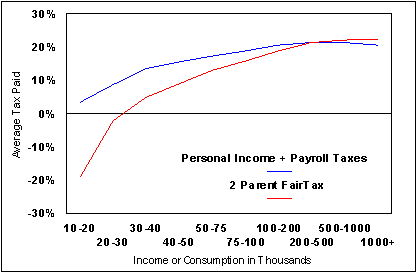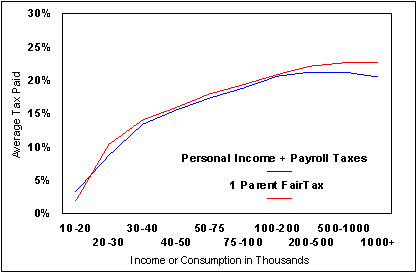FairTax cut for 2-parent families
During an election season, one of the first losers is the truth. The current misinformation campaign against the FairTax has been particularly virulent. Last month the FairTax was being panned by some columnists as a "crackpot scheme," even though it could be collected exactly the same way as its close cousin, the value-added tax, which is the most successful tax in the world. This month the FairTax is being vilified by various columnists as a tax increase for the middle class, even though it would provide a substantial tax cut for two-parent middle class families.
Specifically, in a recent column, George Will asked, "Do you want a president (Mike Huckabee, proponent of a national sales tax of at least 30 percent) pledged to radically increase the proportion of federal taxes paid by the middle class?" Similarly, Time magazine's business and economics columnist Justin Fox wrote a blog piece entitled, "The FairTax and its big break for the $200,000-plus crowd."
The FairTax is a national sales tax that would replace the income taxes, the payroll taxes, and the gift and inheritance taxes. It would be a 30 percent sales tax on retail purchases. Since 30 cents is 23 percent of $1.30 (the amount you would pay on a $1 item), a 30 percent FairTax would cost you about 23 percent of your consumption. To help you pay the tax, you would get a prebate check or a debit card credit at the beginning of each month equivalent to the amount you would pay when buying necessities. In 2007, that amount would have been based upon $10,210 spending per adult and $3,480 spending per child.
Now let's compare how a family of four (two parents, two children) would fare under the FairTax. Ideally we would compare families of four under the FairTax with families of four under the current system, but we don't have statistics that isolate families of four under the current system, nor do we have statistics that break up all the taxes replaced by the FairTax by income level. In the graph below, the blue line shows the overall level of taxation under the current system for just the personal income tax and the payroll taxes, according to Brookings Institution statistics.

As shown in the above graph, two-parent families in the middle class would benefit greatly from a switchover to the FairTax. Families in the $30-40,000 category would only pay an average of 5 percent, not 13 percent (2.6 percent income tax; 10.8 percent payroll tax). Families in the $40-$50,000 category would pay an average of 9 percent, not 16 percent (4.8 percent income; 10.8 percent payroll). Families in the $50-75,000 category would pay an average of 13 percent, not 17 percent (6.6 percent income; 10.7 percent payroll).
If a family were to save money, buy anything used or pay any educational tuition, they would reduce their tax rate further since saving, buying used items or paying educational tuition would all be exempt under the FairTax. Conversely, if they were to spend more than their income, they would increase their tax burden. The FairTax returns control to the taxpayer – if you want to save your money instead of spend it, the government leaves it alone.
Not all taxpayers would fare as well under the FairTax as the two-parent two-child family shown in the above graph. A single parent with one child would receive half the prebate. The following graph compares how they would fare, as compared to the average taxpayer under the current tax system:

The single-parent family shown in the above graph could still reduce its taxation by saving money, paying tuition or by buying used items. Some taxpayers might even find a partner to put their family into the two-parent bracket. But if they do not do any of these, they would pay approximately the same amount under the FairTax, as shown in the graph above, as the average taxpayer pays under the current tax code.
The long-term returns to the poor and middle class would be even better than the short-term returns. According to Dan Mastromarco's August 2006 summary of the predictions of simulation studies, in the long run the FairTax would produce a 27 percent welfare gain for low-income households, an 11 percent gain for middle-income households, and a 5 percent gain for high-income households.
The FairTax is clearly a tax cut for two-parent middle-class families. So, how did George Will and Justin Fox arrive at their conclusion that the FairTax is a tax hike for the middle class? George Will is not an economist, so we'll give him a pass. Maybe he was just repeating what Justin Fox wrote. Justin Fox, on the other hand, is an economics and business columnist. He arrived at his conclusion that the middle class would pay more by using subtraction. He started with the premise that the rich save a higher percentage of their income. (Savings are exempt from the FairTax.) Then he concluded, "Give [the rich] a tax break, and the money will have to come from those lower on the income scale. That's simple arithmetic."
His claim that wealthy people save a much higher percentage of their income than the middle class was once true, but may not be true any longer. As the trade deficits have been growing, wealthy Americans have been selling off their stocks and bonds to foreigners. Although some wealthy people are accumulating wealth that would be exempt from the FairTax until consumed, others are living off of their wealth. Those who are accumulating wealth would pay lower taxes under the FairTax; those who are consuming their wealth would pay higher taxes.
Also, Fox's "simple arithmetic" ignores the fact that the entire pie would be greater under the FairTax, allowing reductions in tax rates across the board. This is mainly true because the FairTax would be applied to U.S. imports and excluded from U.S. exports, and U.S. imports were $760 billion higher than exports in 2006.
The FairTax would especially benefit two-parent families and those who save money. It encourages saving and investing and thus would increase our country's long-term economic growth. In February 2007, five economists from the Beacon Hill Institute at Suffolk University used their model of the economy to predict the effects of the FairTax. They concluded that in just one year GDP would go up by 7.9 percent more than it otherwise would.
In our forthcoming book, we predict that a combination of the FairTax with specific measures to control the government-driven trade deficits would produce a very bright economic future indeed for America. If nothing is done, however, the U.S. economy faces long-term stagnation, or worse, a possible economic collapse and depression.
The FairTax deserves fair coverage.



